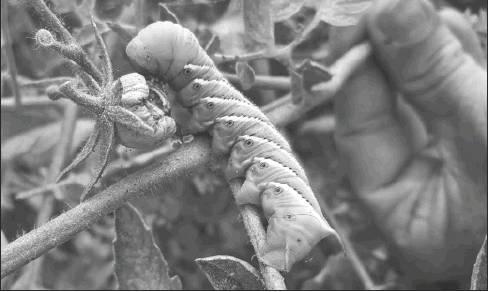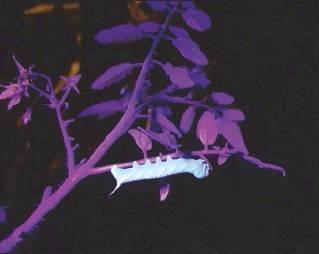Getting Into Gardening
Tomato varieties come and go but the ones with great flavor, a juicy, melting flesh and healthy, easy-togrow vines are the ones we treasure and love to grow in our gardens year after year. Tomatoes can be grown in backyard gardens, containers on the porch, or in a sun room. You’ll even find some folk growing tomatoes in the front yard too. I don’t much care where you grow them I just want everyone to get out and start gardening – and growing tomatoes is a great way to start. But have you ever walked out to the garden expecting to enjoy your lovely tomato plants only to find them completely defoliated overnight? If so, and it happens to all of us, you were most likely hit by the tomato hornworm, or as I think of him, a tomato terrorist!
The tomato hornworm, Manduca quinquemaculata, is much dreaded by vegetable gardeners, because they can devastate tomatoes and other members of the nightshade family. The tomato hornworm is three to four inches long at full size (likely to be the biggest caterpillar we see in our gardens) and green in color, with a black “horn” that projects from the rear of the caterpillar.
This pest is the larval stage of the hawk or sphinx moth, also known as hummingbird moths. The moths overwinter in the soil emerging to mate in late spring. They lay their eggs, which are round and greenish-white, on the undersides of leaves. The eggs hatch in four to five days and the hornworm emerges. It spends the next four weeks growing to full size, after which it will make its way into the soil to pupate.
Tomato hornworms are voracious pests, munching entire leaves, small stems and even parts of the immature fruit. While they are most commonly associated with tomatoes, hornworms are also common pests of eggplants, peppers, and potatoes. Most likely, you’ll notice the damage before you notice the hornworms because their color helps them blend in so well with the plant foliage. But I have learned to ‘shine the light of science’ on this problem with great effect. When I hunt for these pesky ‘pillers, I do it in the dark of night, with a UV flashlight! I bought one online for less than $10.00 and it work like magic.
I appreciate that creatures glowing in the dark might be reminiscent of scary movies, but when you come upon them in real life it’s a pleasure. Think of fireflies winking at the edge of the lawn on a summer’s night, or the waves of light you stir up while swimming among phosphorescent plankton in the sea.
My favorite bioluminescent encounter was while making my way along a dark woodland road without a flashlight, when I spotted strange glowing patches among the trees. Something out of the Brothers Grimm? No, just foxfire, the light emitted by patches of luminous lichen on decaying tree bark. (The name is a version of “folks’ fire,” as in fairies or “the little folk.”)
But here’s a new twist. Science has taught us that the luminosity of some life forms appears to us only when light is altered in some way. I recently learned that tomato hornworms will glow if you shine a black light on them. Some of you might remember the black light as a gadget used to illuminate psychedelic artwork in the ’60s, by narrowing the light spectrum to the UV (ultraviolet) range. But it has broader uses in police work, including the identification of counterfeit money, which lacks a certain ultraviolet mark, and in medicine, for spotting and delineating certain pathogens that are visible in such light.
What’s interesting about the nighttime detection of the hornworm is that it’s extremely hard to see by day. This fat, four-inchlong caterpillar should be easy to find, but it has spent millennia learning how to resemble tomato stems and leaves. You don’t know it’s there until its plant-chomping damage is done. But armed with a black light, you can easily stalk your prey as it glows with a greenish color among the tomato vines. Bioluminescence is sometimes used by animals to frighten off a predator, which in this case is you! But be not unnerved, if you’re repelled by plucking huge, slightly squishy, neon-lighted worms off plants with your fingers, use tongs. But do it gently, because you have an important decision to make before you stomp on them or drop them into soapy water to end their lives. Collect them, then examine them indoors under normal light, and if you see small, white objects, like grains of rice, lined up along a hornworm’s sides, if so, put that one safely back in the garden. The white things are the pupating larvae of a braconid wasp, which are parasitizing the hornworm and will soon destroy it from within. Their offspring will do the same to other harmful garden pests.
So how does one use the blacklight to hunt down the dreaded tomato terrorist? It is actually rather easy. Just follow these simple steps:
1. Take a blacklight flashlight outside when it’s dark. Alternatively, put a blacklight bulb in a small desk lamp and plug it into an extension cord, if necessary, to reach the infested plants.
2. Fill a cup with water and about 1 teaspoon of liquid dishwashing detergent to collect and kill the hornworms. Or just plan to drop them on the ground and stomp them.
3. Shine the blacklight over the plant and examine all its parts, from the ground up. Look at the undersides of the leaves, since this is a common hiding place for hornworms. They’ll glow under the light.
4. Pick off the hornworms from the plant that are not hosting the larvae of braconid wasps and place them in the cup of soapy water or just squish them under foot. Dispose of the hornworms in the garbage.
It’s possible that you will fall in love with this odd creature and not be able to destroy any of its kind. I understand. I’ve seen it to happen to the best of gardeners. In that case, just encourage beneficial insects such as ladybugs and lacewings to patrol your garden, by keeping the yard poison-free. These and other insects prey on hornworm larvae before they grow to monstrous size. This is just a great idea anyway. Ladybugs can be purchased at most plant nurseries, and a black light that emits only UV light can be found online for about $10. After tomato season, you might find other ways to put the black light to use too. For example, you can shine it around your kitchen sink and counters, in the dark, and locate any E. coli bacteria that may have escaped even your best cleaning attempt.




